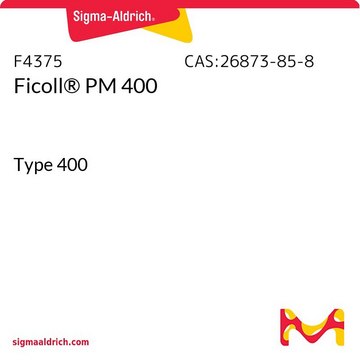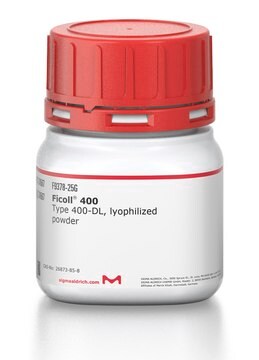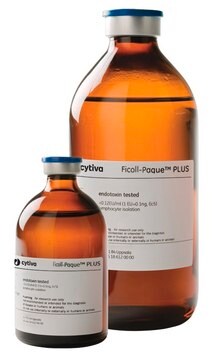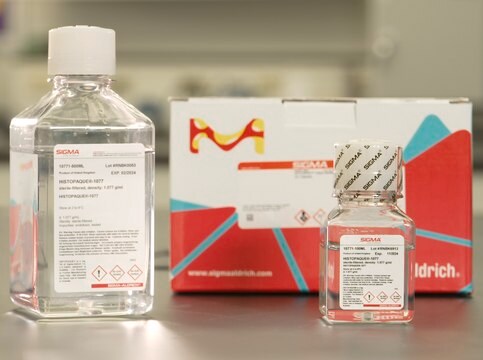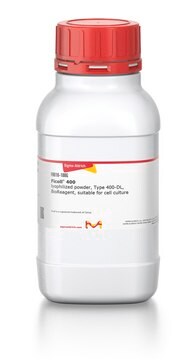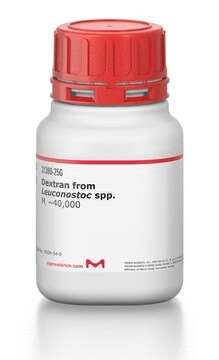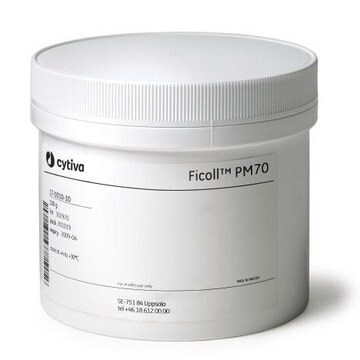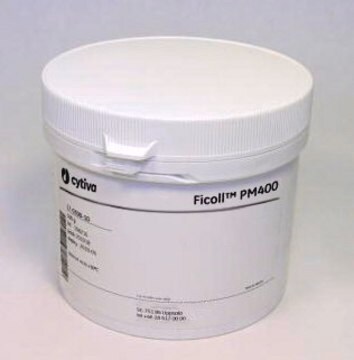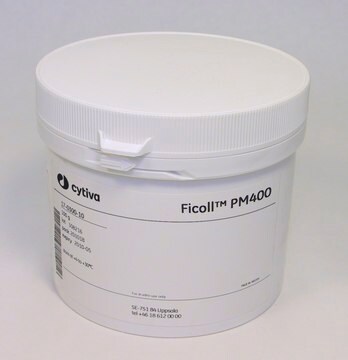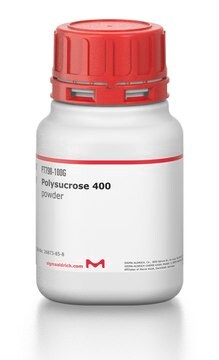F2878
Ficoll® PM 70
Type 70
Synonym(e):
Poly-(saccharose-co-epichlorhydrin)
Anmeldenzur Ansicht organisationsspezifischer und vertraglich vereinbarter Preise
Alle Fotos(1)
About This Item
Empfohlene Produkte
Typ
Type 70
Qualitätsniveau
Form
powder
Mol-Gew.
~70,000
Farbe
white
Löslichkeit
H2O: soluble 100 mg/mL, clear to slightly hazy, colorless to faintly yellow
Suchen Sie nach ähnlichen Produkten? Aufrufen Leitfaden zum Produktvergleich
Allgemeine Beschreibung
Ficoll® PM70, a high molecular weight branched polysaccharide polymer, is believed that they do not contain any ionized groups. This sucrose-polymer is formed by the copolymerization of sucrose with epichlorhydrin.
Anwendung
Ficoll® PM 70 has been used:
- as a macromolecule in a comparative study to evaluate its effect in vitrification solutions
- as a supplement in the vitrification solution for the vitrification procedure of oocytes
- as a component of low serum medium for human lung fibroblast cell culture to promote a crowded environment
Biochem./physiol. Wirkung
Ficoll is commonly used as a macromolecular constituent of vitrification solutions. Due to their dense branching, Ficolls also serve as ideal, nearly spherical molecular crowding agents.
FicollTM PM 70 is used as a macromolecular crowding agent in studies of cell volume signaling and protein refolding.It may be used in tissue engineering and macromolecular conformation research for the development, evaluation, and use of macromolecular crowding (MMC) systems and configurations. Ficoll PM-70 can also be used in vitrification research.
Sonstige Hinweise
Nicht-ionisches synthetisches Polymer aus Saccharose
To gain a comprehensive understanding of our extensive range of Polysaccharides for your research, we encourage you to visit our Carbohydrates Category page.
Rechtliche Hinweise
Ficoll is a registered trademark of Cytiva
Lagerklassenschlüssel
11 - Combustible Solids
WGK
WGK 3
Flammpunkt (°F)
Not applicable
Flammpunkt (°C)
Not applicable
Persönliche Schutzausrüstung
Eyeshields, Gloves, type N95 (US)
Hier finden Sie alle aktuellen Versionen:
Besitzen Sie dieses Produkt bereits?
In der Dokumentenbibliothek finden Sie die Dokumentation zu den Produkten, die Sie kürzlich erworben haben.
Kunden haben sich ebenfalls angesehen
Emmanuel Dauty et al.
Journal of molecular recognition : JMR, 17(5), 441-447 (2004-09-14)
Aqueous environments in living cells are crowded, with up to >50 wt% small and macromolecule-size solutes. We investigated quantitatively one important consequence of molecular crowding--reduced diffusion of biologically important solutes. Fluorescence correlation spectroscopy (FCS) was used to measure the diffusion
Nobuhiko Tokuriki et al.
Protein science : a publication of the Protein Society, 13(1), 125-133 (2003-12-24)
Unfolded states of ribonuclease A were used to investigate the effects of macromolecular crowding on macromolecular compactness and protein folding. The extent of protein folding and compactness were measured by circular dichroism spectroscopy, fluorescence correlation spectroscopy, and NMR spectroscopy in
M B Burg
Cellular physiology and biochemistry : international journal of experimental cellular physiology, biochemistry, and pharmacology, 10(5-6), 251-256 (2000-12-23)
The non-ideal properties of solutions containing high concentrations of macromolecules can result in enormous increases in the activity of the individual macromolecules. There is considerable evidence that macromolecular crowding and confinement not only occur in cells, but that these are
M Al-Habori
The international journal of biochemistry & cell biology, 33(9), 844-864 (2001-07-20)
Macromolecular crowding has been proposed as a mechanism by means of which a cell can sense relatively small changes in volume or, more accurately, the concentration of intracellular solutes. According to the macromolecular theory, the kinetics and equilibria of enzymes
C M Checura et al.
Theriogenology, 67(5), 919-930 (2006-12-19)
This study was designed to evaluate vitrification procedures for in vitro matured bovine oocytes for efficient blastocyst production after warming, IVF and culture. A second goal was to replace serum as the macromolecular component of the vitrification solution, without compromising
Unser Team von Wissenschaftlern verfügt über Erfahrung in allen Forschungsbereichen einschließlich Life Science, Materialwissenschaften, chemischer Synthese, Chromatographie, Analytik und vielen mehr..
Setzen Sie sich mit dem technischen Dienst in Verbindung.